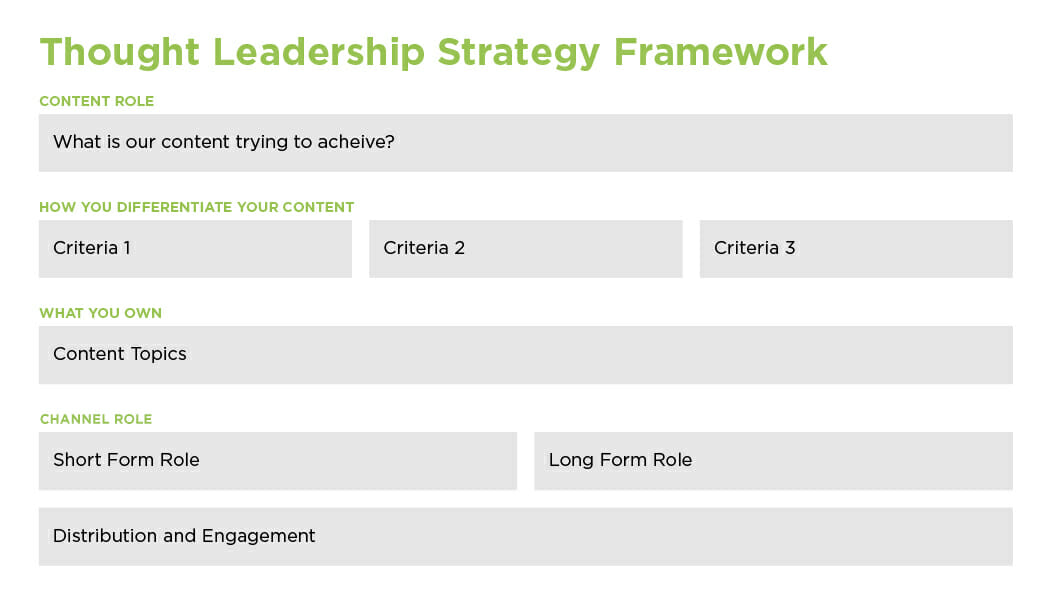Is your thought leadership working?
A framework for creating content that drives business results
We may have grown tired of the expression “content is king,” but the B2B sector’s content obsession shows no sign of abating. Companies continue to invest heavily in content—especially thought leadership—building teams of industry experts and veteran journalists to produce stand-out pieces.
Thought leadership content is an investment that makes business sense. According to a recent Edeleman-LinkedIn B2B Thought Leadership Impact Study, 55% of decision-makers use it when deciding what organizations to work with and 58% said it led directly to the decision to award business to an organization. 61% of decision-makers have even paid a premium price to work with organizations with a reputation for thought leadership.
With potential like this, companies who have made big investments might wonder when they’ll see returns. This is especially true for those who churn out a steady stream of content and hope that sheer volume will increase their odds of producing something that makes an impact. But often, this pressure to feed the content machine forces companies to focus too much on quantity, leading to too many irrelevant pieces that detract from higher-order goals.
Here is where many lose sight of thought leadership’s sole purpose: promoting your business and brand. If your content only has fleeting news relevance or takes a stand that isn’t connected to who you are and what you do, it’s not going to ladder up to your business goals. And it’s only then that content can drive meaningful results.
So how do you create thought leadership content that moves the needle? We’ve devised a framework at Sullivan that looks like this:
- Define thought leadership objectives that support business objectives. What are your specific goals for thought leadership, and how can they power larger organizational goals? Say your #1 business objective is to acquire more small business customers. Alternatively, what if deepening engagement with current clients is more important than acquisition because you already own a majority of the market? Either way, your thought leadership objectives should directly reflect these priorities.
- Align to your audiences’ needs. What are the components of your customers’ jobs? Where do they need the most help? What words do they use when they search for help—or even when they talk to colleagues? What are their perceptions of you and your role in advancing their business and their careers? Knowing the answers to these questions helps to further narrow your thought leadership focus.
- Define ownable, consistent topics. You shouldn’t write about everything. Find the most authentic, salient topics that resonate with your audiences, that are ownable search terms for your business from an SEO perspective, and that your audiences trust you to uniquely deliver. These topics should be evergreen so that you build perceived expertise and stronger search results. With a set of refined topics, you can plan how your thought leadership comes to life.
- Develop the specific criteria that every piece of content needs to meet. Often, organizations will have style guides, but these cover the “how” you sound, not “what” you say. Criteria should consider the substance of the content and be unique to your brand and value proposition. If your customers value the proprietary, aggregated data you have on customer behavior, make sure that every thought leadership communication highlights that data. If you have recognizable subject matter experts who your customers respect, make sure every communication calls out the relevant SME’s perspective. We typically recommend 3-4 criteria, but whatever criteria you choose, adhere to them consistently to differentiate from competitors and build credibility.
- Define a role for each content type, whether short-form, long-form, video, or something else. Again, follow your research and audience insights. You should have a sense of what your audience looks for and their preferred formats. A busy manager might need a snackable, short-form how-to, while an executive faced with an important decision might benefit from a long-form, data-filled report. A healthy mix is recommended to keep it interesting, to hit different audiences, and to cover a range of topics—just make sure there’s always a clear link to your goals and criteria.
- Create a distribution strategy. If you build it, they’ll come, right? Not necessarily. There are plenty of companies that create beautiful thought leadership that isn’t seen by their customers and prospects. While your distribution strategy will be specific to your existing marketing plan and channels, there’s plenty you can do to amplify your content: better targeting newsletters that aggregate top posts, establishing a partnership with a trusted republisher, engaging your customers in contributing content that they will likely share with their networks, and cutting up long form into bite-sized bits for consumption on social channels.
- Measure the right results. Circling back to your business objectives, make sure that the measurement you track matches the outcomes you want. If your objective is greater customer engagement, “new site visits” probably isn’t the right metric. Create clear measurement goals, and then track how each channel, content type, and topic deliver on those objectives.
Right now, engagement is spiking—remote work has spurred more content consumption than ever. It is a perfect time to thoughtfully evaluate your current thought leadership program, identify what’s working and what’s not, and make a plan to focus your team’s efforts in driving value to your business.
